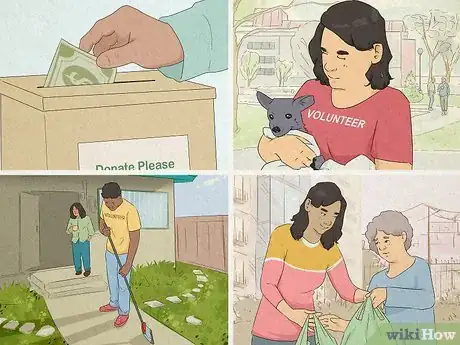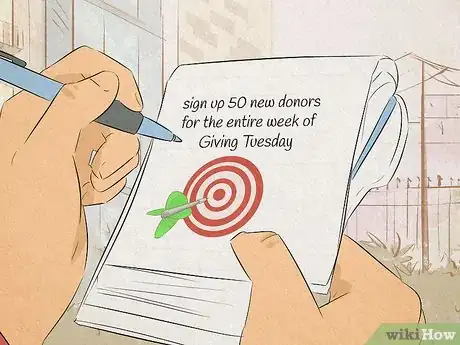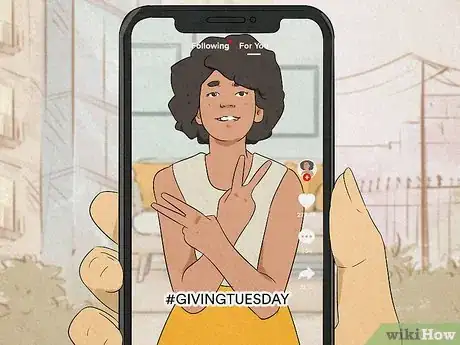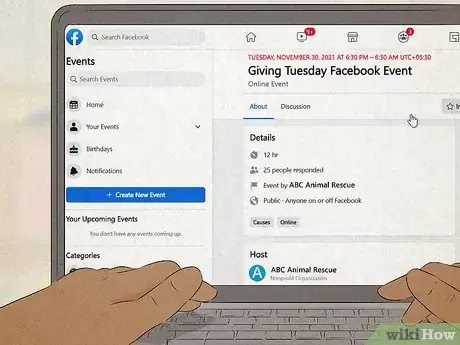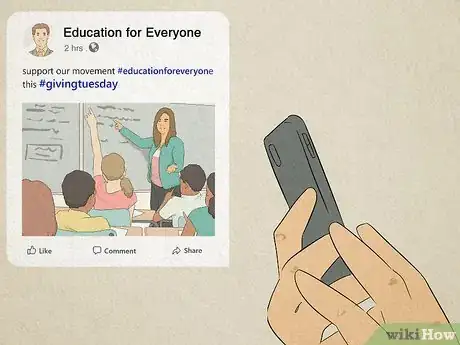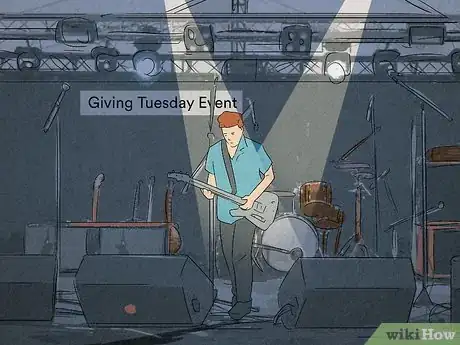This article was co-authored by Rob Wu and by wikiHow staff writer, Jessica Gibson. Rob Wu is the CEO of CauseVox, a digital fundraising platform designed for nonprofits. CauseVox works to help do-gooders raise more money with less effort. Rob has raised over $200,000 for his own nonprofit crowdfunding projects, and his work has been recognized by CNN, Christian Science Monitor, and the Wall Street Journal.
There are 9 references cited in this article, which can be found at the bottom of the page.
This article has been viewed 6,122 times.
Giving Tuesday is quickly becoming one of the most charitable days in the year. It's the Tuesday after Thanksgiving and it's a day to celebrate giving to others. It was originally started in 2012 as a way of reacting against the consumerism of Black Friday. Instead of being a single event or fundraiser, it's become a global movement of generosity. Giving Tuesday usually falls between November 27 and December 3. In 2021, it falls on November 30 and is a great opportunity to fundraise and bring awareness to your non-profit.
Steps
Join the Giving Tuesday movement.
-
Register your campaign on the official site to access support. Although you're not fundraising for the Giving Tuesday organization, you can sign up your organization's fundraiser so the contributions are symbolically counted toward a global goal. By registering your campaign with the form on https://www.givingtuesday.org/united-states/bring-radical-generosity-to-your-community/, you'll also have access to tools and resources like:[1] X Research source
- Logos and graphics for social media
- A campaign toolkit for nonprofits
- Sample campaign messages
- Tips for rallying donors
Give back to your community if you don't have an organization.
-
Individuals are a driving force of the Giving Tuesday movement. If you're not part of an organization, find ways to support them or do something generous for your community. As an individual participant, you can:[2] X Research source
- Donate money
- Volunteer your time
- Share an organization's campaign posts
- Do something kind for your neighbors
- Reach out to the elderly in your area
Set measurable goals for your campaign.
-
Identify your overall mission and make short, actionable goals. For instance, your overall mission might be to get more donors, raise money, or get participants involved in your cause. Then, you can set goals that are specific, measurable, attainable, relevant, and time-bound.[3] X Research source
- For example, if your mission is to get more donors, your campaign goals might be to sign up 50 new donors for the entire week of Giving Tuesday.
- Another goal might be to raise an additional $1,000 of donations on Giving Tuesday along with signing up 100 participants by Friday of that week.
Make your campaign fun or personal.
-
Your Giving Tuesday campaign should stand out from all the others. Instead of just asking for donations, make it engaging! You might set up a matching challenge—if you raise a specific amount, you'll unlock additional donations—or share personal stories from the group you're fundraising for. If you've got a celebrity or local personality, ask them to help you promote the campaign.[4] X Research source
- Try to be as interactive as possible so people feel compelled to give and participate. You might do a livestream on Facebook, issue a TikTok challenge, or create donation stickers for Instagram followers to use on their accounts.
Set up an online fundraising page.
-
Add this to your website so donors know where to contribute. For an easier option, make an event page for your Facebook account or create a donation form that you can put on the front page of a website that you already manage. The Giving Tuesday website has graphics and logos you can use to set these up![5] X Research source
- Your donation form should be simple and secure so your donors can quickly and easily contribute to your campaign.
- If you've got a website or event page, post frequently in the days leading up to Giving Tuesday. This builds momentum and excitement for the actual day.
- Nowadays, every offline fundraising event needs an online component to engage more people and to give information. The same applies to online campaigns, as they also need to have some sort of offline presence.
Bring attention to your campaign on social media.
-
Generate interest by posting personal stories, pictures, and quotes. People are more likely to donate if they feel inspired by your cause. You've already come up with your mission. Now, use compelling posts to share that mission![6] X Research source You must have a narrative with compelling reasons as to why your campaign is important and warrants donations.
- For example, if you're raising money for a homeless shelter, you might post personal stories or quotes from someone who's benefited from your organization's efforts.
- You could post pictures that show the impact of your organization. For example, if you support kids going to school, you could post pictures of them with backpacks full of school supplies.
- Schedule your posts so you're publishing something at least once or twice in the days leading up to Giving Tuesday—you don't want to post once on the day and be done, but you don't want to overwhelm potential donors either.
Create a peer-to-peer campaign.
-
Use individual social connections to fundraise for your organization. Reach out to the supporters that you already have and ask them to share social media posts to raise awareness for your campaign. You could also ask people to use popular tags like:[7] X Research source
- #givingtuesday
- #nonprofit
- #givingback
- #iamgrateful
- #charityevent
- #givingtuesday2021
Set up a texting option for your campaign.
-
Sign up with a text-to-give service and choose a keyword for your campaign. The text-to-give site that you use will give you a short code. Then, you can direct donors to simply send a text to the short code saying something like "Give (amount) to (keyword)." Share this information with your contact list and on your social media platforms.[8] X Research source
- For example, before Giving Tuesday, say, "Giving Tuesday is almost here! To help our efforts, text Hope to 25252 with the amount you'd like to donate."
Organize an in-person event.
-
Host a gala, festival, concert, party, or trivia night to fundraise. You could ask for donations to attend the event or do fundraising at the event itself. For instance, charge a slight entrance fee to attend a fundraising auction. Think about partnering with other organizations or businesses, too! You might ask a local community center to host a canned food or warm clothing drive with your charity.[9] X Research source
- Don't forget to publicize your event in the weeks before Giving Tuesday. Build anticipation to build a good turnout.
Get local publicity for the movement.
-
Reach out to local radio stations or newspapers to cover your campaign. When you pitch the idea, make a connection between what your organization is doing at the local level with the global Giving Tuesday movement. This makes your campaign unique and personal to your area so newspapers or local tv stations are more likely to cover your event.[10] X Research source
- This is also a fantastic way to raise awareness in your community for what your organization does.
- If you can't get newspaper, radio, or tv coverage, don't worry! You can always spread the news yourself. Print off flyers with information about your campaign and ask friends to distribute them to community centers, shopping malls, and public notice boards around your area.
Show a fundraising thermometer to inspire donors.
-
This tracks your goals and motivates donors to give. You can post your fundraising thermometer to your website so people can watch real-time progress. It's a good way to be accountable while inspiring people to help you meet your goal.[11] X Research source
- Keep your fundraising thermometer simple so people can see at a glance what your goal is and where your campaign is currently at.
- For example, your thermometer could have a goal of $50,000 listed at the top. Then, you could show where you're currently at—10%, 25%, 50%, and so on.
Follow up with your supporters after Giving Tuesday.
-
Thank your donors in the following days and communicate how the event went. Publish a post or email that shares your Giving Tuesday successes. Your donors will feel included and more invested in your organization so they're more likely to support you in the future.[12] X Research source
- Your message might include something like, "Thanks to your efforts, Homes for Kids raised $12,000! That's $2,000 over our goal! Our community thanks you for your generous support. Together we can find a caring home for every child in need."
You Might Also Like

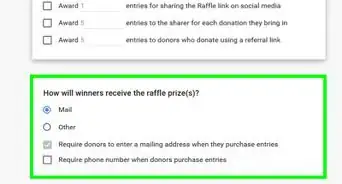





 How to Raffle a Car (Legally and Successfully)
How to Raffle a Car (Legally and Successfully)
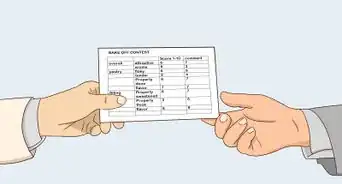





References
- ↑ https://www.givingtuesday.org/united-states/bring-radical-generosity-to-your-community/
- ↑ https://www.givingtuesday.org/about/faq/
- ↑ https://www.givingtuesday.org/blog/goal-setting-givingtuesday/
- ↑ https://www.givingtuesday.org/givingtuesday-toolkit-for-nonprofits/
- ↑ https://www.givingtuesday.org/logos/
- ↑ https://donorbox.org/nonprofit-blog/giving-tuesday-ideas/
- ↑ https://donorbox.org/nonprofit-blog/giving-tuesday-ideas/
- ↑ https://www.agroup.com/files/uploads/textify_giving-tuesday-tips.pdf
- ↑ https://www.givingtuesday.org/givingtuesday-toolkit-for-nonprofits/
About This Article


